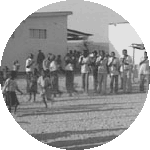
 |
||
 |
First pressed on shellacs, later transfered to digital format,
these files of original music are now widely available for the first time
over the internet. |
 |
 |

By 1946 it seemed clear that unless someone devoted more time and energy to appraising the social value of authentic African music it would go by default, and that at a time when the various countries of Africa were contemplating the introduction of full-time radio broadcasting in African vernaculars with no recorded repertoires of local music and little comprehension of the complexities of the subject. The schools and universities of Central and Southern Africa, which one would have supposed would have been the first to undertake the study of the major oral art of the country, had failed, with minor exceptions, to give African music any permanent place in their disciplines.
“This was the challenge with which we were faced in 1946. The question remained as to how it was to be met, how funds and equipment were to be obtained and what techniques should be employed to ensure that the unwritten compositions of genuine African musicians would not be ignored or thrust aside by the artificially stimulated demands of commerce and radio, and the intrusion of non-African popular music on films and records.
Hugh Tracey